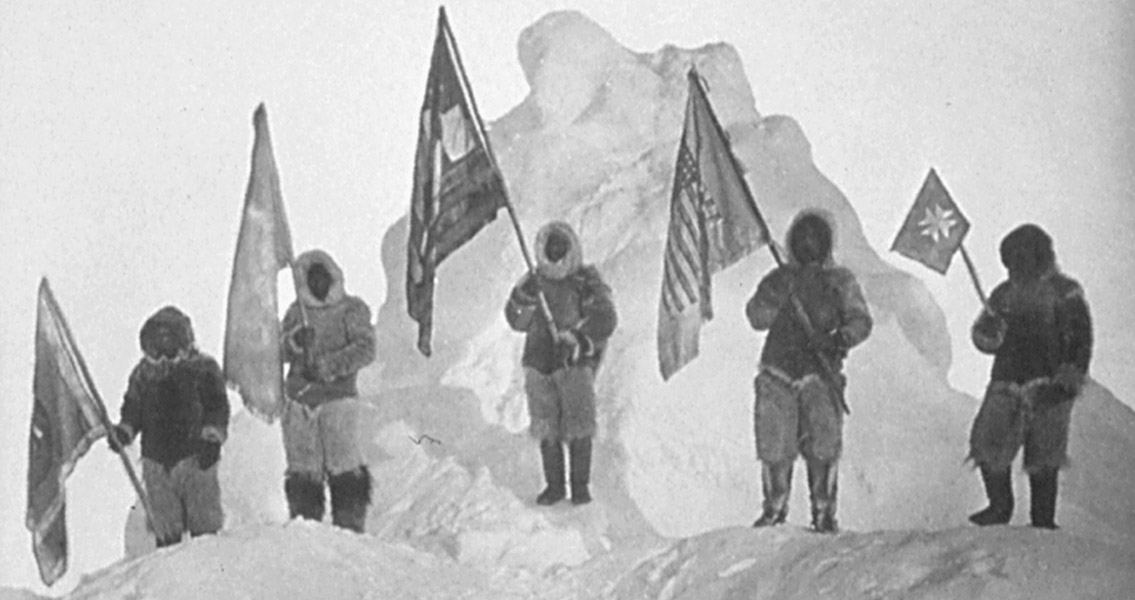<![CDATA[6th April 1909 is the day that American Robert Peary claimed to have led an expedition to the North Pole, supposedly completing the last great challenge for the world's explorers. The event triggered one of the longest running and heated controversies of the twentieth century, as competing claims and accusations of navigational errors brought Peary's declaration into question. For several months prior to the expedition, Peary and his associates had observed the ways of people indigenous to the Arctic region to try and gain an insight into how to survive the perilous journey north. They elected to set off from Canada's Ellesmere Island, rather then Greenland, which had been the starting point for many previous attempts at reaching the North Pole. Peary decided to launch the expedition in winter, believing the challenges set by the harsher weather conditions would be offset by the benefits of the ice sheets the team had to travel across being firmer. On 1st March 1909, Peary and his entourage of 23 men, 19 sleds and 133 dogs set off on their quest for the North Pole. As they progressed farther and farther north, the expedition lightened its load and reduced its number of personnel. By the 6th April, only six members of the crew remained, Peary, his long time assistant Matthew Henson, and four local guides - Oatah, Egingwah, Seegloo, and Ookeah. The rest of the men constructed an igloo, while Peary made his way to the supposed site of the North Pole and planted the American flag into the ice, an iconic image, but one which might have been misguided. Before Peary's discovery could be announced in the press, another claim to reaching the North Pole was made by Dr. Frederick A. Cook. What's more, Cook stated that his expedition had reached the Pole in April 1908, a full year before Peary. Intriguingly, Cook had been missing in the Arctic, presumed dead, for nearly a year before returning with stories of reaching the legendary landmark. The competing claims captured imaginations, "Whatever the truth is, the situation is as wonderful as the Pole," wrote journalist Lincoln Steffens in 1909. "And whatever they found there, those explorers, they have left there a story as great as a continent." Of course, any endeavour to mark the North Pole is incredibly challenging. While the South Pole is situated on a fixed land mass, the North lays on drifting sea ice. If Peary and Cook did reach the North Pole, it would have been impossible to leave a permanent marker at the location. A bitter dispute emerged between Cook and Peary, two men that had previously worked together, as both tried to stake their claim to being the first to reach the North Pole. Ultimately, Cook's claim was discredited after some of his team's photographic evidence was brought into question, and Peary was officially recognised by the US government in 1911 as being the first person to reach the North Pole. Through the years, however, Peary's reputation has been pulled apart, a result of not only the skepticism surrounding his supposed achievements, but his treatment of the indigenous peoples in the frozen lands of the North. Peary, a naval officer as well as explorer, is sometimes described as a ruthless imperialist who pursued his goals with little consideration for local people. In Greenland in 1897, he had his men open the graves of several deceased natives and exhumed them without permission from the relevant tribes, selling the remains to the American Museum of National History. He also brought six living natives of Greenland into the United States, three children and three adults, four of which died following exposure to influenza. It could be argued that such behaviour shouldn't be judged by our modern standards, Peary's approach was possibly more acceptable in his own time. However, it paints an image of him which sits in stark contrast to that of Cook for example, who learned the indigenous people's dialects and integrated himself into their culture, going so far as adopting their diet. In 1988, a study published in National Geographic threw serious doubts on Peary's achievements. The article questioned Peary's diaries, and used other newly released documents to challenge the navigational methods and record keeping used by the expedition. It suggested the six men had actually fallen between 50-100km short of the North Pole. On the other hand, some historians still claim that Cook could have reached the North Pole. The debate started in 1909 still rages today, and the chances are the question of whether Peary or Cook reached the North Pole will never be resolved. ]]>
Peary Declares Himself the First to Reach the North Pole
